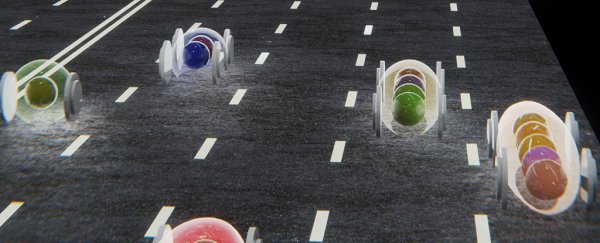Scientists have observed a new state of electronic matter on the quantum scale, one that forms when electrons clump together in transit, and it could advance our understanding and application of quantum physics.
Movement is key to this new quantum state. When electric current is applied to semiconductors or metals, the electrons inside usually travel slowly and somewhat haphazardly in one direction.
Not so in a special type of medium known as a ballistic conductor, where the movement is faster and more uniform.
The new study shows how in very thin ballistic conducting wires, electrons can gang up – creating a whole new quantum state of matter made solely from speeding electrons.
"Normally, electrons in semiconductors or metals move and scatter, and eventually drift in one direction if you apply a voltage," says physicist Jeremy Levy, from the University of Pittsburgh. "But in ballistic conductors the electrons move more like cars on a highway."
"The discovery we made shows that when electrons can be made to attract one another, they can form bunches of two, three, four and five electrons that literally behave like new types of particles, new forms of electronic matter."
Ballistic conductors can be used for stretching the boundaries of what's possible in electronics and classical physics, and the one used in this particular experiment was made from lanthanum aluminate and strontium titanate.
Interestingly, when the researchers measured the levels of conductance they found they followed one of the most well-known patterns in mathematics – Pascal's triangle. As conductance increased, it stepped up in a pattern that matches one of the rows of Pascal's triangle, following the order 1, 3, 6, 10 and so on.
"The discovery took us some time to understand but it was because we initially did not realise we were looking at particles made up of one electron, two electrons, three electrons and so forth," says Levy.
This clumping of electrons is similar to the way that quarks bind together to form neutrons and protons, according to the researchers. Electrons in superconductors can team up like this too, joining together in pairs to coordinate movement.
The findings may have something to teach us about quantum entanglement, which in turn is key to making progress with quantum computing and a super-secure, super-fast quantum internet.
According to Levy, it's another example of how we're reverse engineering the world based on what we've found from the discovery of the fundamentals of quantum physics – building on important work done in the last few decades.
"Now in the 21st century, we're looking at all the strange predictions of quantum physics and turning them around and using them," says Levy.
"When you talk about applications, we're thinking about quantum computing, quantum teleportation, quantum communications, quantum sensing – ideas that use the properties of the quantum nature of matter that were ignored before."
The research has been published in Science.
